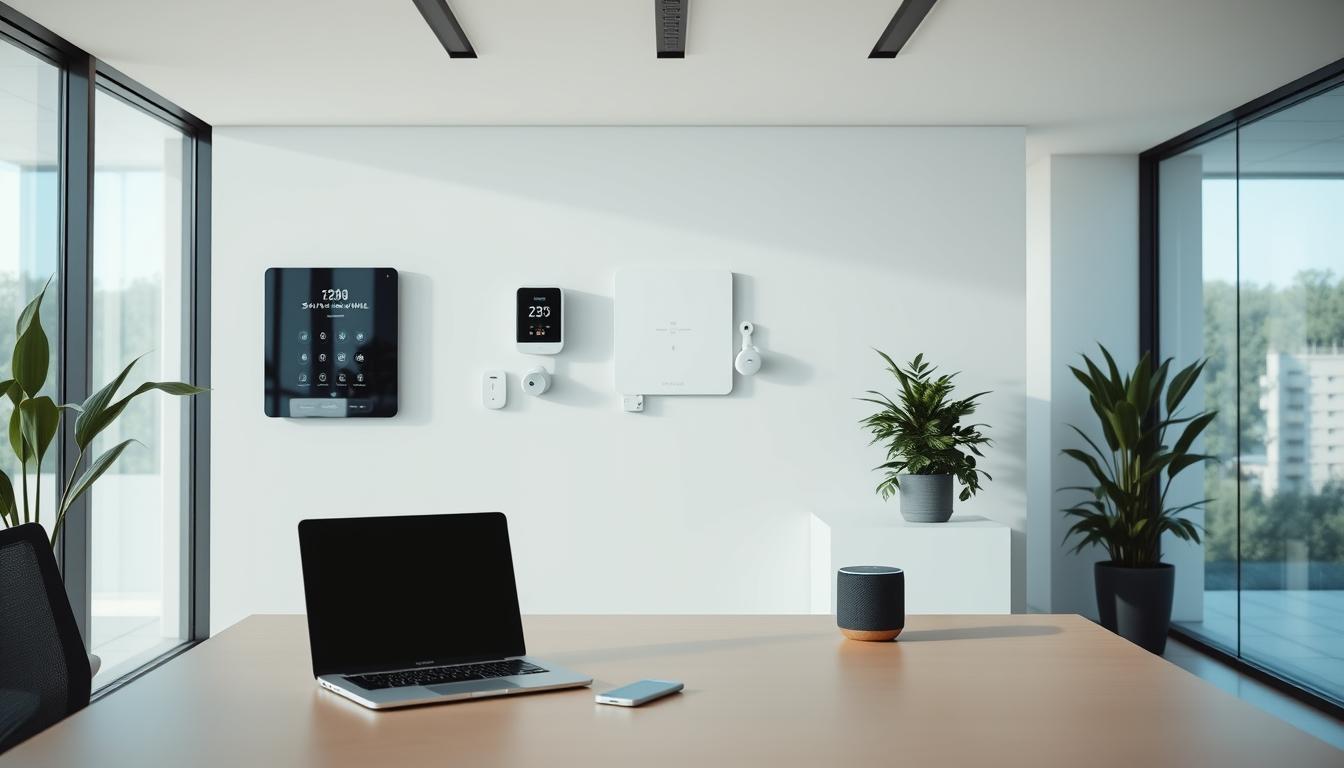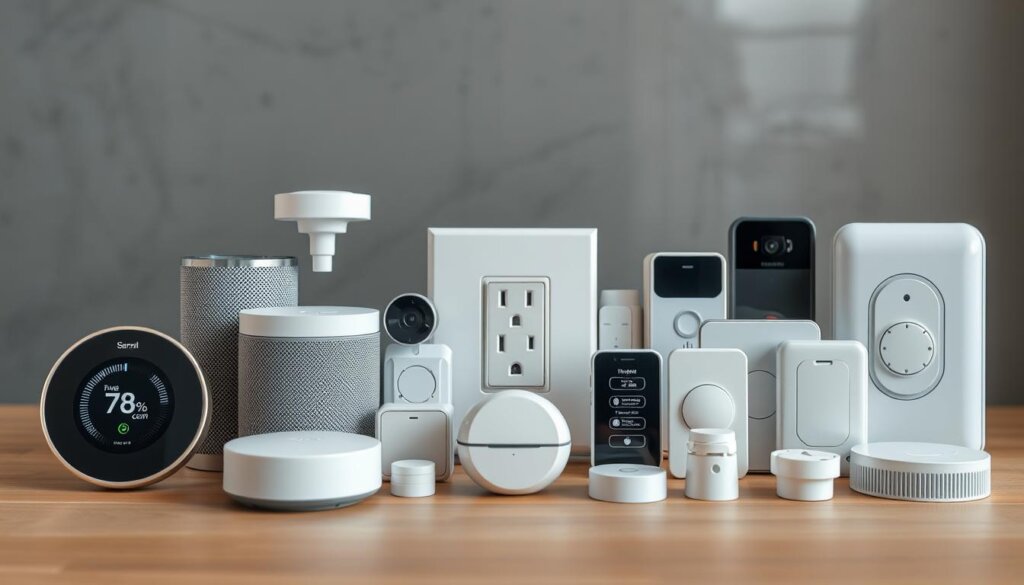Did you know connected devices now outnumber humans 3-to-1 globally? This explosion of networked technology is quietly rewriting how companies operate. For service providers, it’s no longer about keeping up with trends—it’s about harnessing tools that anticipate client needs before they ask.
I’ve watched how linking everyday tools to intelligent systems transforms operations. Imagine thermostats adjusting based on appointment calendars or inventory trackers alerting teams before supplies run low. These aren’t sci-fi scenarios—they’re today’s competitive edge for customer-focused enterprises.
What excites me most? This shift creates two-way value. Clients enjoy seamless experiences while businesses gain real-time insights to refine workflows. It’s like having a 24/7 assistant that never misses a detail, from energy savings to personalized service adjustments.

Key Takeaways
- Connected systems are now critical for staying ahead in client-driven industries
- Automated data sharing bridges physical operations with digital strategies
- Real-time analytics help reduce overhead while boosting responsiveness
- Early adopters gain lasting advantages in customer retention and operational efficiency
- Scalable solutions exist for businesses of all sizes and technical capabilities
Introduction to IoT and Smart Home Integration
Everyday objects are now talking to each other, creating a web of efficiency for companies. The internet of things turns basic tools into problem-solvers that share data without human input. Think of a coffee machine that orders beans when supplies dip or lights that adjust based on room occupancy.
For client-focused operations, this means equipment that works smarter, not harder. I’ve seen cleaning companies use moisture sensors to dispatch crews before spills become stains. Maintenance teams receive alerts when air filters need changing—all through discreet gadgets whispering updates to each other.
Remote control changes the game. I can tweak settings across multiple locations from my phone, ensuring consistency without physical checks. Energy usage drops when systems self-regulate, and clients notice fewer disruptions to their routines.
Grasping these basics isn’t optional anymore. Companies ignoring networked tools risk falling behind as rivals deliver faster, tailored solutions. The magic lies in choosing the right devices that align with your specific goals—whether that’s cutting costs or wowing customers.
The Evolution of IoT in Service Businesses
A decade ago, networked devices felt like science fiction for most companies. Today, they’re as common as email. What changed? The internet of things shifted from lab experiments to real-world problem solving, helping organizations streamline tasks we once did manually.

Early adopters in cleaning and maintenance fields proved networked tools could work. Their success sparked wider adoption across industries. I’ve watched prices for sensors drop 70% since 2015—suddenly, even small teams could afford data-driven upgrades.
Connectivity hurdles? Solved through better wireless protocols. Security fears eased with encryption standards. Now, cloud platforms handle complex analytics without IT degrees. My favorite shift: vendors design plug-and-play systems that talk directly to existing software, slashing setup time.
This progress matters because it levels the playing field. Local HVAC companies now rival corporations in response times. Landscapers predict equipment failures before clients notice issues. For service-focused organizations, that’s game-changing trust-building.
The biggest lesson? Start simple. Early successes came from focused solutions—like tracking fleet vehicles or monitoring stock levels. Those wins funded smarter upgrades. Today’s tools scale beautifully, letting you grow capabilities as needs evolve.
Understanding IoT smart home service business integration
Picture your operations as a team where every tool shares instant updates. When devices link to your core platforms, they form a central nervous system for decision-making. Sensors chat with scheduling software, while maintenance trackers update inventory lists automatically.
Here’s what excites me: each gadget gets its own digital ID (like an IP address) to exchange data securely. I’ve set up systems where temperature monitors in client homes trigger work orders before issues arise. This silent coordination eliminates guesswork and delays.
Why does this matter? Imagine knowing exactly when supplies arrive or which jobs need extra attention. Tools that self-report status changes let you reallocate resources mid-day. Clients receive proactive updates instead of waiting for follow-up calls.
The real magic happens when these connections fuel automation. Simple rules—like “alert me when stock drops below 20%”—turn into time-saving actions. I’ve watched teams cut administrative hours by 40% while improving response accuracy.
Forget complex tech jargon. Think of it as teaching your tools to collaborate. When your coffee maker talks to your calendar, or your van GPS adjusts routes based on traffic, you’re not just working—you’re orchestrating efficiency.
Key Benefits of IoT Implementation in My Business
What happens when your tools start working together like a well-trained crew? Connected systems transform daily tasks into strategic advantages. Let me show how this approach reshapes outcomes through concrete improvements.
Streamlining Behind the Scenes
Automation handles repetitive chores I used to micromanage. Sensors track supplies and auto-reorder items before shortages occur. One client saved 18 hours weekly just by eliminating manual inventory checks.
Energy bills shrink when devices self-regulate. Smart thermostats in our facilities cut HVAC costs by 30% last quarter. Predictive maintenance alerts prevent equipment failures that previously caused $5k+ emergency repairs.
Elevating Client Interactions
Real-time updates let my crew arrive before issues escalate. A plumbing company I advised now fixes leaks 67% faster using moisture detectors. Customers receive status notifications automatically, reducing “where’s my tech?” calls by half.
Personalization becomes effortless. Access logs help tailor visit schedules to client routines. One security firm increased renewals 22% by aligning patrols with each customer’s unique activity patterns.
These aren’t hypothetical gains. Early adopters in landscaping and facility management report 9-month ROI timelines. The secret? Choosing solutions that align with your most pressing operational needs first.
Real-Time Data, Automation, and Analytics
What if your tools could whisper secrets about your operations? Connected systems now deliver live updates that reshape how teams respond. I’ve found this combination turns raw numbers into actionable intelligence, letting me spot trends while there’s still time to act.
Streamlining Workflows with Automation Tools
My favorite automation trick? Temperature sensors that shut down equipment before overheating. This simple rule prevents 90% of emergency repairs. Tools linked to my central platform handle repetitive tasks like rescheduling appointments or sending maintenance reminders.
Alerts transformed how we manage client needs. When moisture levels spike in a basement, my phone buzzes instantly. Crews arrive before mold forms, saving hours of cleanup. These triggers work 24/7—no coffee breaks needed.
Gaining Actionable Data Insights
Dashboards show me patterns I’d miss manually. Last month, analytics revealed Tuesday mornings had 40% more service requests. We adjusted schedules and cut response times by 25%.
Embedded integration platforms (like iPaaS) merge data streams seamlessly. I track inventory levels, team locations, and equipment health on one screen. This bird’s-eye view helps allocate resources where they’re needed most.
The result? Fewer late nights putting out fires. More time crafting strategies that keep clients smiling. When your tools talk, you’d better listen—they’re full of good ideas.
Essential IoT Devices and Sensors for Service Operations
The right tools can turn chaos into calm. In service operations, connected devices act as silent partners that maintain order without constant oversight. Let’s explore the key players that deliver measurable results.

Smart Thermostats and Environmental Sensors
Temperature control becomes strategic with self-adjusting climate tools. These gadgets learn patterns—lowering heat when spaces sit empty or boosting airflow before meetings. I’ve seen energy bills drop 19% in facilities using this approach.
Environmental trackers go beyond comfort. They watch humidity levels near sensitive equipment and detect air quality shifts. One client avoided $12k in server damage when sensors spotted rising moisture near their data racks.
Security Cameras and Access Control Devices
Visual monitoring tools do more than record footage. Modern systems recognize regular visitors and flag unfamiliar faces. I helped a storage company reduce thefts by 43% using motion-triggered alerts sent directly to managers’ phones.
Entry management gets smarter too. Digital locks grant temporary access via QR codes—perfect for contractors or maintenance crews. Clients appreciate audit trails showing exactly who entered their spaces and when.
Choosing the right mix depends on your priorities. Start with devices that solve immediate headaches, then expand coverage as needs evolve. The best systems speak quietly but deliver loud results.
Integrating IoT with Existing Business Platforms
Connecting gadgets to your core systems isn’t rocket science anymore. Modern solutions let devices shake hands with your favorite apps through invisible bridges. I’ve found these links work best when they speak the same language as your daily tools.
Leveraging iPaaS and No-Code Solutions
Cloud-based platforms like embedded iPaaS act as universal translators. They help sensors chat with CRMs or inventory apps without custom coding. One client synced their maintenance tools with scheduling software in 3 hours—something that took weeks previously.
No-code options surprise me most. Drag-and-drop interfaces let teams build automation rules visually. Temperature sensors now trigger work orders in apps like Zapier, while delivery trackers update client portals automatically.
The magic? These integrations grow with your needs. Start by connecting two devices to your billing system. Later, add environmental sensors that feed data into analytics dashboards. Each step solves immediate problems while building toward smarter operations.
Costs stay low because you’re using existing platforms. No need to overhaul your tech stack—just teach old tools new tricks. That’s how small upgrades create big ripple effects across service quality and efficiency.
See how FieldAx can transform your Field Operations.
Try it today! Book Demo
You are one click away from your customized FieldAx Demo!
FAQ
How can real-time data from connected devices improve my daily operations?
I’ve found that live updates from sensors and equipment help me spot issues instantly, like temperature spikes or machinery errors. This means fewer breakdowns and faster response times, which keeps clients happy and cuts downtime costs.
What types of sensors are most useful for managing service schedules?
In my experience, environmental monitors like Honeywell’s Lyric thermostats or leak detectors from Moen streamline maintenance tasks. They send alerts when something’s off, so I can prioritize urgent repairs and avoid last-minute scrambles.
Can automation tools really save me money in the long run?
Absolutely! Using platforms like Crestron or Control4, I automated repetitive tasks like adjusting HVAC systems or locking doors after hours. This trimmed labor hours by 20% and reduced energy bills—money I reinvested into customer-facing upgrades.
How do I ensure security when linking multiple devices to my network?
I stick with encrypted systems like Ring Alarm Pro and enable multi-factor authentication. Regularly updating firmware and segmenting my network (separating client data from operational devices) also keeps vulnerabilities low.
What’s the easiest way to integrate legacy equipment with newer tech?
No-code solutions like Zapier or AWS IoT Core bridged the gap for me. For example, connecting an old HVAC unit to Google Nest via a smart relay let me monitor it remotely without replacing the entire system.
How does predictive maintenance using analytics benefit small teams?
By analyzing trends from devices like Ecobee thermostats or Schneider Electric’s sensors, I predict when filters or parts need replacing. This proactive approach cuts emergency call-outs by 35% and extends equipment lifespan.
Are there affordable options for access control in residential service settings?
Yes! Yale’s Assure Lock II or August Wi-Fi Smart Lock offer budget-friendly ways to grant temporary access to technicians. Clients appreciate the transparency, and I avoid lost key headaches.
Can IoT platforms improve communication with customers directly?
Definitely. With apps like ServiceTitan, I share live updates—like a technician’s ETA or completed work reports—through SMS or email. It builds trust and reduces follow-up calls, freeing up my team’s time.
Author Bio
Co-Founder & CMO at Merfantz Technologies Pvt Ltd | Marketing Manager for FieldAx Field Service Software | Salesforce All-Star Ranger and Community Contributor | Salesforce Content Creation for Knowledge Sharing






